英语分词的用法
- 格式:doc
- 大小:34.50 KB
- 文档页数:3
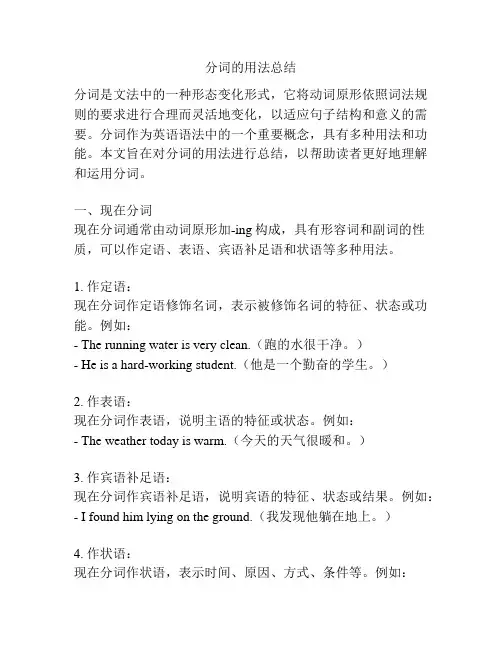
分词的用法总结分词是文法中的一种形态变化形式,它将动词原形依照词法规则的要求进行合理而灵活地变化,以适应句子结构和意义的需要。
分词作为英语语法中的一个重要概念,具有多种用法和功能。
本文旨在对分词的用法进行总结,以帮助读者更好地理解和运用分词。
一、现在分词现在分词通常由动词原形加-ing构成,具有形容词和副词的性质,可以作定语、表语、宾语补足语和状语等多种用法。
1. 作定语:现在分词作定语修饰名词,表示被修饰名词的特征、状态或功能。
例如:- The running water is very clean.(跑的水很干净。
)- He is a hard-working student.(他是一个勤奋的学生。
)2. 作表语:现在分词作表语,说明主语的特征或状态。
例如:- The weather today is warm.(今天的天气很暖和。
)3. 作宾语补足语:现在分词作宾语补足语,说明宾语的特征、状态或结果。
例如:- I found him lying on the ground.(我发现他躺在地上。
)4. 作状语:现在分词作状语,表示时间、原因、方式、条件等。
例如:- Walking along the street, she suddenly saw her old friend.(她走在街上,突然看到了她的老朋友。
)- Being tired, I went to bed early.(我累了,早早上床睡觉。
)二、过去分词过去分词通常由动词原形加上-ed或-en构成,具有形容词的性质,可以作定语、表语、宾语补足语和状语等多种用法。
1. 作定语:过去分词作定语,修饰名词或代词,表示被修饰词的特征、状态或情况。
例如:- The broken window needs to be repaired.(这个破窗户需要修理。
)- The lost key has been found.(丢失的钥匙已经找到了。
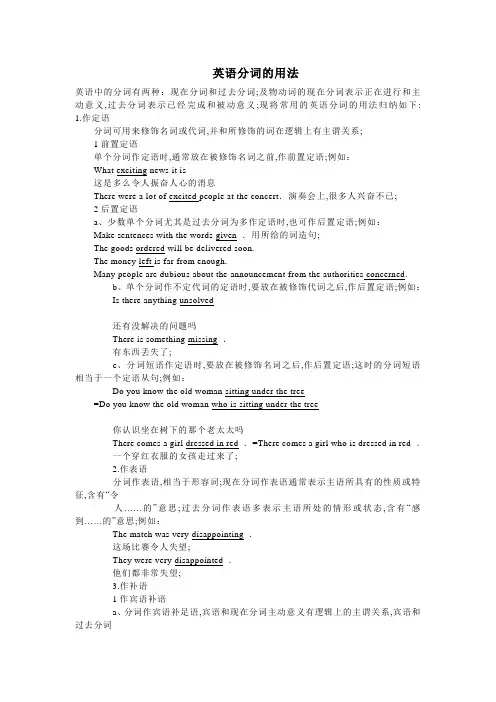
英语分词的用法英语中的分词有两种:现在分词和过去分词;及物动词的现在分词表示正在进行和主动意义,过去分词表示已经完成和被动意义;现将常用的英语分词的用法归纳如下: 1.作定语分词可用来修饰名词或代词,并和所修饰的词在逻辑上有主谓关系;1前置定语单个分词作定语时,通常放在被修饰名词之前,作前置定语;例如:What exciting news it is这是多么令人振奋人心的消息There were a lot of excited people at the concert.演奏会上,很多人兴奋不已;2后置定语a、少数单个分词尤其是过去分词为多作定语时,也可作后置定语;例如:Make sentences with the words given .用所给的词造句;The goods ordered will be delivered soon.The money left is far from enough.Many people are dubious about the announcement from the authorities concerned.b、单个分词作不定代词的定语时,要放在被修饰代词之后,作后置定语;例如:Is there anything unsolved还有没解决的问题吗There is something missing .有东西丢失了;c、分词短语作定语时,要放在被修饰名词之后,作后置定语;这时的分词短语相当于一个定语从句;例如:Do you know the old woman sitting under the tree=Do you know the old woman who is sitting under the tree你认识坐在树下的那个老太太吗There comes a girl dressed in red .=There comes a girl who is dressed in red .一个穿红衣服的女孩走过来了;2.作表语分词作表语,相当于形容词;现在分词作表语通常表示主语所具有的性质或特征,含有“令人……的”意思;过去分词作表语多表示主语所处的情形或状态,含有“感到……的”意思;例如:The match was very disappointing .这场比赛令人失望;They were very disappointed .他们都非常失望;3.作补语1作宾语补语a、分词作宾语补足语,宾语和现在分词主动意义有逻辑上的主谓关系,宾语和过去分词被动意义有逻辑上的动宾关系;分词通常用在see,hear, watch,notice,feel,find等感官动词或have,get,make等使役动词的宾语之后,补充说明宾语的动作或状态;例如:I found the man beating his dog there .=I found that the man was beating his dog there .我发现那个人在那儿打狗;I found the man beaten black and blue .=I found that the man was beaten black and blue .我发现那个人被打得浑身青一块紫一块儿的;过去分词在动词have,get之后作宾语补足语时,常常表示这动作不是由主语完成的,而是由别人完成的;例如:I want to have my shoes repaired .= My shoes are repaired by somebody .我想修鞋;b、现在分词和不定式作宾语补足语在意义上有所不同;现在分词作宾语补足语,表示动作正在进行,即动作处在发生过程中,还没有结束;而不定式作宾语补足语表示动作的全过程,即动作已结束了;例如:I saw him going out.我看见他正在往外走;正在发生I saw him go out.我看见他出去了;全过程Do you hear someone knocking at the door 你听见有人在敲门吗正在发生Yes,I heard him knock three times.是的,我听见他敲了三下;全过程2作主语补足语带有分词作宾语补足语的句子如果改为被动语态时,分词不变,但这时分词就不再作宾补足语,而是作主语补足语;例如:A man was seen sitting under the tree .看见有个人坐在那棵树下;The door was found opened.发现门被打开;4.作状语现在分词作状语,一般句子主语就是分词的主语;1时间状语分词作时间状语相当于when引导的时间状语从句,若两个动作同时发生,可以在分词前加入连词when或while;例如:Seeing the teacher entering the room,the students stood up.= When the students saw the teacher entering the room,they stood up.学生们看到老师进来,都站了起来;Seen from the moon,the earth looks like a ball.= When the earth is seenfrom the moon,it looks like a ball.从月球上看,地球像个圆球;2原因状语分词作原因状语时相当于as,since或because所引导的原因状语从句;例如:Not knowing what to do about it,I asked my teacher for advice.= Because Ididn’t know what to do about it,I asked my teacher for advice.由于我不知道该怎么办,就征求老师的意见;Encouraged by his speech,the students decided to work hard.= As the students were encouraged by his speech,they decided to work hard.受他讲话的鼓舞,学生们决定努力学习;3条件状语分词作条件状语时相于if或unless引导的条件状语从句,也可在分词短语前加if或unless;例如:Reading more carefully,you’ll learn something new.= If you read more carefully,you’ll learn something new.如果你读得更认真些,你就会学到一些新东西;Given another chance,he’ll succeed.= If he is given another chance,he’ll succeed.如果再给他一次机会,他一定会成功;4结果状语分词作结果状语时相当于that引导的结果状语从句或并列句;例如:The bottle dropped to the ground, breaking into pieces.=The bottle dropped to the ground that it broke into pieces.瓶子掉在地上摔碎了;The old writer died all of a sudden, leaving his works unfinished.=The old writer died all of a sudden,and he left his works unfinished.这位年迈的作家没有完成他的著作就突然离开人世了;5让步状语分词短语作让步状语相当于让步状语从句;例如:Tired,the old man continued to work.= Even though the old man was tired ,he continued to work.尽管老人累了,他仍继续干活;Although built many years ago, the machines are still working in perfect order.= Although the machines were made many years ago, they are still working in perfect order.虽然这些机器是很多年前制造的,但现在仍然运行良好;6方式状语或伴随状语分词短语作方式状语或伴随状语时,没有对应的状语从句;例如:He came,running back to tell me the good news.他跑回来告诉我这个好消息;The teacher hurried to the office, followed by five students.五个学生跟着老师匆匆忙忙地走进了办公室;。
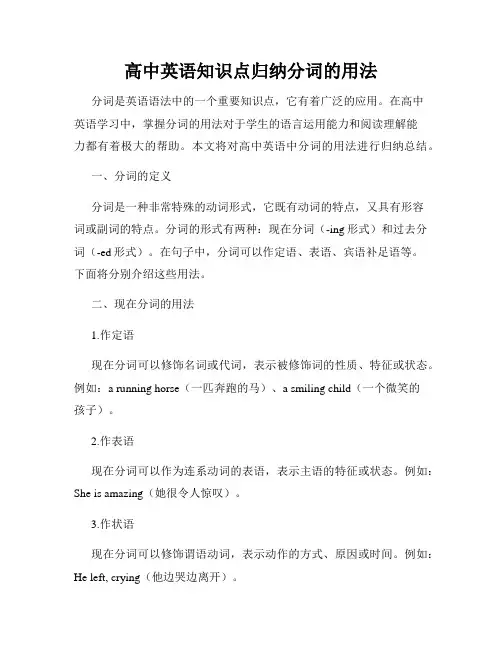
高中英语知识点归纳分词的用法分词是英语语法中的一个重要知识点,它有着广泛的应用。
在高中英语学习中,掌握分词的用法对于学生的语言运用能力和阅读理解能力都有着极大的帮助。
本文将对高中英语中分词的用法进行归纳总结。
一、分词的定义分词是一种非常特殊的动词形式,它既有动词的特点,又具有形容词或副词的特点。
分词的形式有两种:现在分词(-ing形式)和过去分词(-ed形式)。
在句子中,分词可以作定语、表语、宾语补足语等。
下面将分别介绍这些用法。
二、现在分词的用法1.作定语现在分词可以修饰名词或代词,表示被修饰词的性质、特征或状态。
例如:a running horse(一匹奔跑的马)、a smiling child(一个微笑的孩子)。
2.作表语现在分词可以作为连系动词的表语,表示主语的特征或状态。
例如:She is amazing(她很令人惊叹)。
3.作状语现在分词可以修饰谓语动词,表示动作的方式、原因或时间。
例如:He left, crying(他边哭边离开)。
三、过去分词的用法1.作定语过去分词可以修饰名词或代词,表示被修饰词的性质、特征或状态。
例如:a broken window(一个破损的窗户)、a written report(一份书面报告)。
2.作表语和状语过去分词也可以作为连系动词的表语,表示主语的特征或状态。
例如:The door was closed(门是关着的)。
过去分词还可以修饰谓语动词,表示动作的结果。
例如:She arrived, tired(她疲惫地到达了)。
四、分词的完成时态在句子中,分词还可以和助动词have、has、had连用,形成完成时态。
一般现在分词加上have/has构成现在完成分词,过去分词加上had构成过去完成分词。
例如:Having finished his homework, he went to bed(做完作业后,他去睡觉了)。
五、现在分词和过去分词的区别现在分词和过去分词的区别主要在于时间和动作性质。
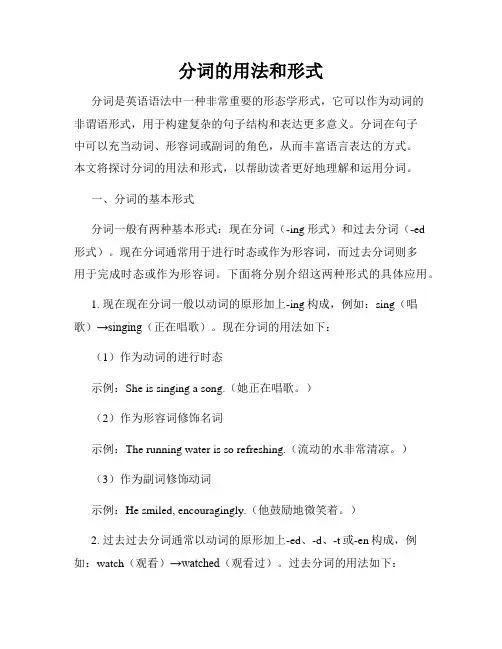
分词的用法和形式分词是英语语法中一种非常重要的形态学形式,它可以作为动词的非谓语形式,用于构建复杂的句子结构和表达更多意义。
分词在句子中可以充当动词、形容词或副词的角色,从而丰富语言表达的方式。
本文将探讨分词的用法和形式,以帮助读者更好地理解和运用分词。
一、分词的基本形式分词一般有两种基本形式:现在分词(-ing形式)和过去分词(-ed形式)。
现在分词通常用于进行时态或作为形容词,而过去分词则多用于完成时态或作为形容词。
下面将分别介绍这两种形式的具体应用。
1. 现在现在分词一般以动词的原形加上-ing构成,例如:sing(唱歌)→singing(正在唱歌)。
现在分词的用法如下:(1)作为动词的进行时态示例:She is singing a song.(她正在唱歌。
)(2)作为形容词修饰名词示例:The running water is so refreshing.(流动的水非常清凉。
)(3)作为副词修饰动词示例:He smiled, encouragingly.(他鼓励地微笑着。
)2. 过去过去分词通常以动词的原形加上-ed、-d、-t或-en构成,例如:watch(观看)→watched(观看过)。
过去分词的用法如下:(1)作为动词的完成时态示例:He has finished his homework.(他已经完成作业。
)(2)作为形容词修饰名词示例:I read an interesting book.(我读了一本有趣的书。
)(3)作为被动语态中的非谓语动词示例:The car was repaired by a mechanic.(汽车被修理工修理了。
)二、分词的进一步应用除了基本形式的用法外,分词还有一些其他的应用。
下面将介绍分词的进一步应用,以帮助读者更好地理解和运用分词。
1. 分词作为主语分词可以作为句子的主语,通常用现在分词形式。
例如:Reading is my hobby.(阅读是我的爱好。
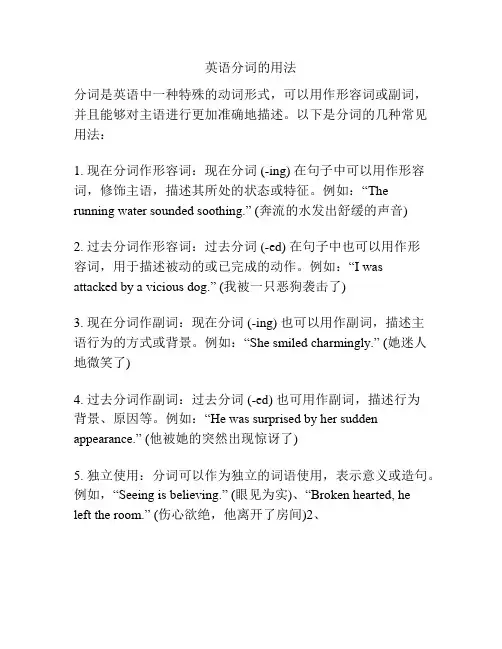
英语分词的用法
分词是英语中一种特殊的动词形式,可以用作形容词或副词,并且能够对主语进行更加准确地描述。
以下是分词的几种常见用法:
1. 现在分词作形容词:现在分词 (-ing) 在句子中可以用作形容词,修饰主语,描述其所处的状态或特征。
例如:“The running water sounded soothing.” (奔流的水发出舒缓的声音)
2. 过去分词作形容词:过去分词 (-ed) 在句子中也可以用作形
容词,用于描述被动的或已完成的动作。
例如:“I was attacked by a vicious dog.” (我被一只恶狗袭击了)
3. 现在分词作副词:现在分词 (-ing) 也可以用作副词,描述主
语行为的方式或背景。
例如:“She smiled charmingly.” (她迷人地微笑了)
4. 过去分词作副词:过去分词 (-ed) 也可用作副词,描述行为
背景、原因等。
例如:“He was surprised by her sudden appearance.” (他被她的突然出现惊讶了)
5. 独立使用:分词可以作为独立的词语使用,表示意义或造句。
例如,“Seeing is believing.” (眼见为实)、“Broken hearted, he
left the room.” (伤心欲绝,他离开了房间)2、。
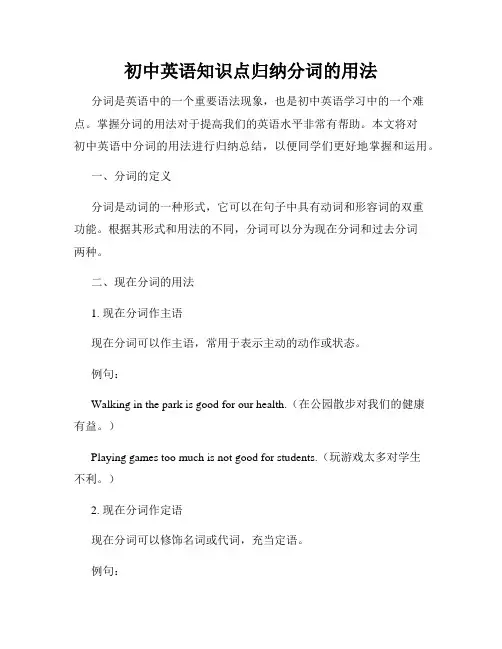
初中英语知识点归纳分词的用法分词是英语中的一个重要语法现象,也是初中英语学习中的一个难点。
掌握分词的用法对于提高我们的英语水平非常有帮助。
本文将对初中英语中分词的用法进行归纳总结,以便同学们更好地掌握和运用。
一、分词的定义分词是动词的一种形式,它可以在句子中具有动词和形容词的双重功能。
根据其形式和用法的不同,分词可以分为现在分词和过去分词两种。
二、现在分词的用法1. 现在分词作主语现在分词可以作主语,常用于表示主动的动作或状态。
例句:Walking in the park is good for our health.(在公园散步对我们的健康有益。
)Playing games too much is not good for students.(玩游戏太多对学生不利。
)2. 现在分词作定语现在分词可以修饰名词或代词,充当定语。
例句:The book written by Mark Twain is very popular.(马克·吐温写的这本书非常受欢迎。
)She is a hard-working student.(她是一个勤奋的学生。
)3. 现在分词作宾语补足语现在分词可以作宾语补足语,用来描述或补充说明及物动词的动作。
例句:I saw him lying on the grass.(我看到他躺在草地上。
)She heard the news, leaving her in shock.(她听到这个消息后,震惊不已。
)4. 现在分词作状语现在分词可以作时间、原因、伴随等状语,用来修饰整个句子或主句。
例句:Feeling hungry, he decided to cook some noodles.(因为感到饿了,他决定煮点面条。
)Being tired, she went to bed early.(因为感到疲倦,她早早上床休息了。
)三、过去分词的用法1. 过去分词作定语过去分词可以修饰名词或代词,充当定语。
![英语语法分词用法详解[英语语法详解:分词]](https://uimg.taocdn.com/a16060ce0b1c59eef8c7b4fe.webp)
英语语法分词用法详解[英语语法详解:分词]第八章分词一.概念:分词分为现在分词和过去分词两种,是一种非谓语动词形式二.相关知识点精讲:1.现在分词的用法:1)做表语:Hewasveryamusing.Thatbookwasratherboring.很多动词的现在分词都可以作表语:exciting,interesting,encouraging,disappointing,confusing ,touching,puzzling.2)作定语:上面所出现的现在分词都可以用作定语,修饰一个名词:Thatmusthavebeenaterrifyingexperience.Ifoundhimacharmingperson.现在分词短语还可以放在名词的后面修饰名词,相当于一个定语从句:Thereareafewboysswimmingintheriver.Thereisacarwaitingoutside.3)作状语:现在分词短语可以表示一个同时发生的次要的或伴随的动作:FollowingTom,westartedtoclimbthemountain. Openingthedrawer,hetookoutabox. Takingakeyoutofhispocket,heopenedthedoor.现在分词短语还可以表示原因,相当于一个原因状语从句:Notknowingheraddress,wecouldn’tgetintouchwithher. Beingunemployed,hehasn’tgotmuchmoney.现在分词短语还可以表示时间,相当于一个时间状语从句:Hearingthenews,theyalljumpedwithjoy. Returninghome,hebegantodohishomework. Jimhurthisarmwhileplayingtennis.。
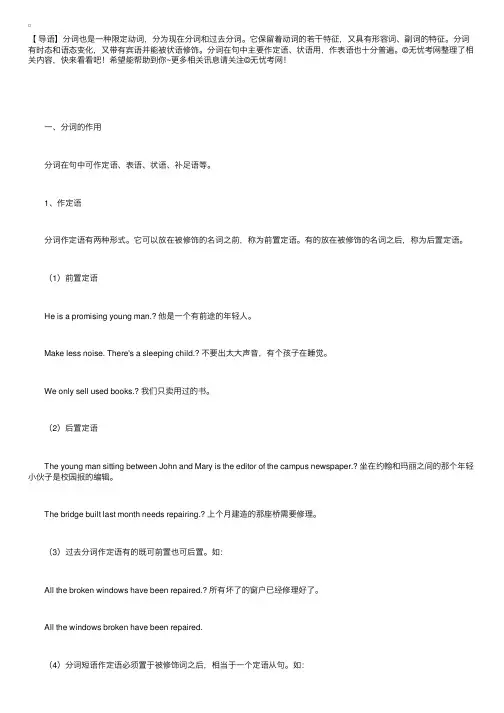
【导语】分词也是⼀种限定动词,分为现在分词和过去分词。
它保留着动词的若⼲特征,⼜具有形容词、副词的特征。
分词有时态和语态变化,⼜带有宾语并能被状语修饰。
分词在句中主要作定语、状语⽤,作表语也⼗分普遍。
©⽆忧考⽹整理了相关内容,快来看看吧!希望能帮助到你~更多相关讯息请关注©⽆忧考⽹! ⼀、分词的作⽤ 分词在句中可作定语、表语、状语、补⾜语等。
1、作定语 分词作定语有两种形式。
它可以放在被修饰的名词之前,称为前置定语。
有的放在被修饰的名词之后,称为后置定语。
(1)前置定语 He is a promising young man.? 他是⼀个有前途的年轻⼈。
Make less noise. There's a sleeping child.? 不要出太⼤声⾳,有个孩⼦在睡觉。
We only sell used books.? 我们只卖⽤过的书。
(2)后置定语 The young man sitting between John and Mary is the editor of the campus newspaper.? 坐在约翰和玛丽之间的那个年轻⼩伙⼦是校园报的编辑。
The bridge built last month needs repairing.? 上个⽉建造的那座桥需要修理。
(3)过去分词作定语有的既可前置也可后置。
如: All the broken windows have been repaired.? 所有坏了的窗户已经修理好了。
All the windows broken have been repaired. (4)分词短语作定语必须置于被修饰词之后,相当于⼀个定语从句。
如: Those wishing to join this club should sign here.? 想加⼊本俱乐部的⼈在这⾥签名。
? (=Those who wish to join the club should sign here.) The man, having been disturbed so badly, almost lost his memory.? 由于被严重困扰,这个⼈⼏乎失去了记忆。
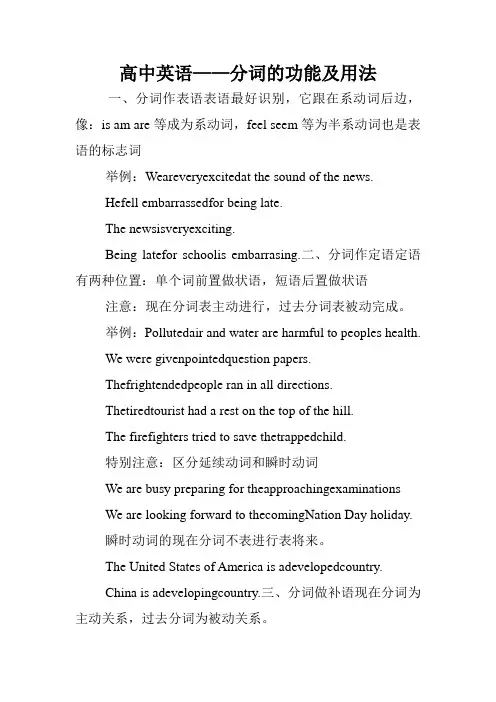
高中英语——分词的功能及用法一、分词作表语表语最好识别,它跟在系动词后边,像:is am are等成为系动词,feel seem等为半系动词也是表语的标志词举例:Weareveryexcitedat the sound of the news.Hefell embarrassedfor being late.The newsisveryexciting.Being latefor schoolis embarrasing.二、分词作定语定语有两种位置:单个词前置做状语,短语后置做状语注意:现在分词表主动进行,过去分词表被动完成。
举例:Pollutedair and water are harmful to peoples health.We were givenpointedquestion papers.Thefrightendedpeople ran in all directions.Thetiredtourist had a rest on the top of the hill.The firefighters tried to save thetrappedchild.特别注意:区分延续动词和瞬时动词We are busy preparing for theapproachingexaminationsWe are looking forward to thecomingNation Day holiday.瞬时动词的现在分词不表进行表将来。
The United States of America is adevelopedcountry.China is adevelopingcountry.三、分词做补语现在分词为主动关系,过去分词为被动关系。
举例:He found his mindplaying with other childrenon the playground.I had my electric bikerepairedyesterday.He left the toprunning.He always keeps the drawerlocked.分词短语做补语举例:She came home from work only to find her housebroken into.We found the bosssatisfied with our work.I saw the busfilled with passagers.I noticed herchatting on the phone.四、分词作状语分词作状语在主句前表:时间,原因,条件,让步。
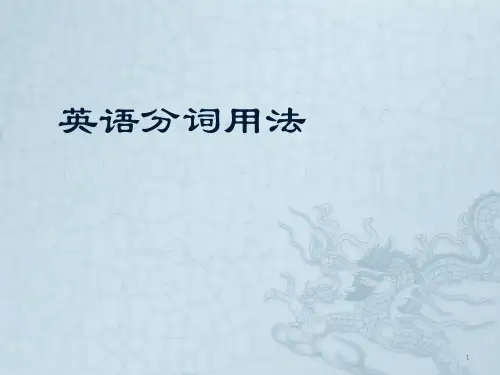
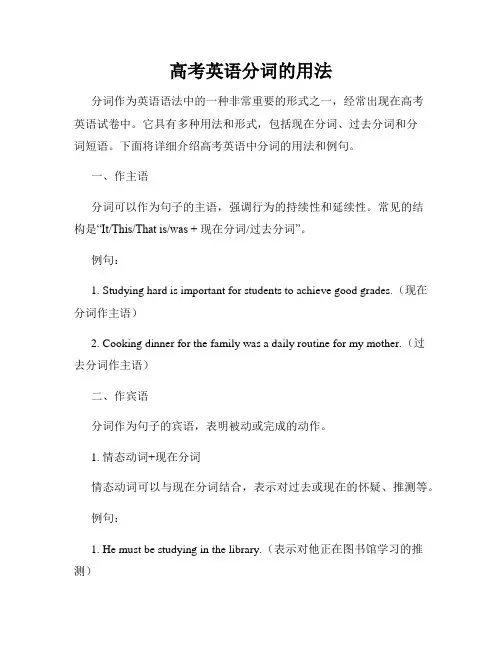
高考英语分词的用法分词作为英语语法中的一种非常重要的形式之一,经常出现在高考英语试卷中。
它具有多种用法和形式,包括现在分词、过去分词和分词短语。
下面将详细介绍高考英语中分词的用法和例句。
一、作主语分词可以作为句子的主语,强调行为的持续性和延续性。
常见的结构是“It/This/That is/was + 现在分词/过去分词”。
例句:1. Studying hard is important for students to achieve good grades.(现在分词作主语)2. Cooking dinner for the family was a daily routine for my mother.(过去分词作主语)二、作宾语分词作为句子的宾语,表明被动或完成的动作。
1. 情态动词+现在分词情态动词可以与现在分词结合,表示对过去或现在的怀疑、推测等。
例句:1. He must be studying in the library.(表示对他正在图书馆学习的推测)2. They could be waiting for the bus.(表示他们可能正在等公交车)2. 动词+不定式/现在分词有些动词后面可以接不定式或现在分词作宾语,但含义略有区别。
例句:1. I enjoy reading novels in my spare time.(不定式作宾语)2. She finished writing her report yesterday.(现在分词作宾语)三、作定语/状语分词可以作为定语修饰名词或作状语修饰动词、形容词等。
1. 现在分词作定语现在分词作为定语,修饰名词,表示主动或进行中的动作。
例句:1. The running water sounds refreshing.(现在分词修饰名词)2. The students standing in front won the first prize.(现在分词修饰名词)2. 过去分词作定语过去分词作为定语,表示被动、完成或说明状态。
分词的分类及用法总结一、什么是分词?分词是指将一个复杂的句子分解成一个主句和一个或多个从句,从而使句子的结构更加清晰明了。
分词在英语语法中属于非谓语动词的一种形式,主要用于修饰主句的主语或宾语,以及表示原因、条件、时间等各种关系。
二、分词的基本形式分词主要有两种形式,即现在分词和过去分词。
现在分词以-ing结尾,过去分词根据动词的不规则变化进行构词。
三、分词的用法1. 现在分词用作形容词现在分词可用于描述人、事物或现象的性质和状态。
例:The running water sounded soothing.(奔流的水声听起来很舒服。
)2. 过去分词用作形容词过去分词可用于描述被动、完成或说明状态。
例:The broken vase lay on the floor.(打碎的花瓶摆在地板上。
)3. 现在分词用作主动性动词现在分词可作为主动性动词,表示正在进行的动作。
例:She is painting a picture.(她正在画一幅画。
)4. 现在分词用作被动性动词现在分词可作为被动性动词,表示被动的、正在进行的动作。
例:The car is being repaired.(汽车正在维修。
)5. 现在分词和过去分词用作状语现在分词和过去分词可用作状语,表示动作的原因、时间、条件或方式。
例:Feeling tired, she decided to take a break.(感到疲倦,她决定休息一下。
)Having finished his homework, he went out to play.(完成作业后,他出去玩了。
)6. 独立结构分词现在分词或过去分词放在句子开头或结尾,与主句之间没有直接的句法联系,构成独立结构。
例:Smiling, she greeted her friends.(微笑着,她向朋友们打招呼。
)四、分词的分类1. 现在分词和过去分词作后置定语这种分词修饰名词,放在名词后面,起到定语的作用。
英语分词用法学习方法分词用法详析分词也是一种限定动词,分为现在分词和过去分词。
它保留着动词的若干特征,又具有形容词、副词的特征。
分词有时态和语态变化,又带有宾语并能被状语修饰。
分词在句中主要作定语、状语用,作表语也十分普遍。
一、分词的形式语态时态主动语态被动语态一般式doingbeingdone完成式havingdonehavingbeendone其否定形式是在doing之后加上not。
二、分词的作用分词在句中可作定语、表语、状语、补足语等。
1、作定语分词作定语有两种形式。
它可以放在被修饰的名词之前,称为前置定语。
有的放在被修饰的名词之后,称为后置定语。
(1)前置定语Heisapromisingyoungman.他是一个有前途的年轻人。
Makelessnoise.There’sasleepingchild.不要出太大声音,有个孩子在睡觉。
Weonlysellusedbooks.我们只卖用过的书。
(2)后置定语TheyoungmansittingbetweenJohnandMaryistheeditorofthecampusnewspaper.坐在约翰和玛丽之间的那个年轻小伙子是校园报的编辑。
Thebridgebuiltlastmonthneedsrepairing.上个月建造的那座桥需要修理。
(3)过去分词作定语有的既可前置也可后置。
如:Allthebrokenwindowshavebeenrepaired.所有坏了的窗户已经修理好了。
Allthewindowsbrokenhavebeenrepaired.(4)分词短语作定语必须置于被修饰词之后,相当于一个定语从句。
如: Thosewishingtojointhisclubshouldsignhere.想加入本俱乐部的人在这里签名。
(=Thosewhowishtojointheclubshouldsignhere.)Theman,havingbeendisturbedsobadly,almostlosthismemory.由于被严重困扰,这个人几乎失去了记忆。
英语中的分词在英语中,分词(Participles)是一种动词的非限定形式,通常以-ing(现在分词)或-ed、-en、-t、-n(过去分词)结尾。
分词可以用作形容词,也可以用在一些复杂的动词时态中。
以下是关于分词的主要用法:●现在分词(Present Participle):1.以-ing结尾,如"playing," "reading," "walking"。
2.作为形容词使用,描述正在进行的动作或事物的特征。
例句:The playing children seemed happy.翻译:玩耍的孩子们似乎很开心。
3.用于进行时态(Present Continuous Tense)。
例句:She is reading a book.翻译:她正在读一本书。
●过去分词(Past Participle):1.过去分词的形式有多种,通常以-ed结尾,如"played," "talked";也可以是不规则的形式,如"broken," "written"。
2.作为形容词使用,描述已完成的动作或事物的状态。
例句:The broken window needs to be fixed.翻译:需要修理的破窗户。
3.用于完成时态(Present Perfect Tense, Past Perfect Tense)。
例句:They have eaten lunch already.翻译:他们已经吃过午餐了。
4.用于被动语态。
例句:The letter was written by Tom.翻译:这封信是汤姆写的。
分词在英语中也有其他一些用法,如独立分词、分词短语等。
分词的灵活运用可以使语言更富有表现力和变化。
英语分词的用法(一)英语分词的用法什么是英语分词?分词是将一个长句子分成短语或单词的方法。
英语分词是英语中一个重要的语法概念,通过将一个句子分成可管理的部分,可以使读者更好地理解长句子的含义。
分词的作用•更好地理解长句子的含义•帮助语言学习者发掘句子的语法和结构,提高阅读和写作能力•使句子更清晰,更易读,更容易理解分词的几种形式1.现在分词:通常以 -ing 结尾,可以被用作形容词,表示正在进行的动作。
例如:The running water sounds soothing.(流水的声音非常舒缓)2.过去分词:通常以 -ed 结尾,可以被用作形容词,表示已经发生的动作。
例如:The broken vase needs to be fixed.(破碎的花瓶需要被修好)3.原形复合词:由动词和副词或介词组成的短语,可以作为形容词或副词。
例如:The well-known actor arrived at the party.(著名的演员来参加派对了)4.不定式:以“to” 开始的动词短语,可以作为名词、形容词或副词。
例如:To study English every day is important.(每天学习英语很重要)分词的应用1.作形容词:分词可用于描述人、物、事物等形容词的用法。
例如:The excited children ran to the playground.(兴奋的孩子们跑到操场上)2.作副词:分词可用于描述动作发生的方式和情况。
例如:Heleft the office, slamming the door behind him.(他离开办公室,狠狠地关上了门)3.作补语:分词可用于补充说明主语或宾语的情况。
例如:Ibecame interested in English after studying abroad.(我在国外留学后对英语产生了兴趣)4.作主语:分词可用于作为句子的主语。
分词的用法总结例句一、分词的基本概念和用法在语法学中,分词是动词的一种形式,可以作为句子的主语、表语、宾语补足语等成分。
同时,分词也可以完成谓语的功能。
1. 动词变分词动词经过特定形式的变化可以变成分词。
一般而言,英语中有两种类型的分词:现在分词和过去分词。
现在分词以-ing结尾,如:running、laughing;过去分词多数加-ed或者-d结尾(但也有不带-e结尾和不规则变化的情况),如:worked、written。
2. 现在分词作主语和表语现在分词作主语时,表示一个正在进行或习惯性发生的动作:- Jogging in a park can be very refreshing.(晨跑在公园里非常令人舒爽)- Shopping online has become increasingly popular.(网购越来越受欢迎)现在分词作表语时,与系动词be连用,说明句子主语所具备的特征:- The children are dancing happily.(孩子们正在快乐地跳舞)- She is wearing a beautiful dress.(她穿着漂亮的礼服)3. 过去分词作定语和宾语补足语过去分词作定语时,修饰名词或代词,表示被动、完成或者状态:- The broken vase is beyond repair.(这个破碎的花瓶无法修复)- The stolen wallet was found in the park.(丢失的钱包在公园被找到了)过去分词作宾语补足语时,用于补充说明及物动词的宾语,并且通常表示动作的结果、状态或特征:- I found the door unlocked.(我发现门是开着的)- He had his car repaired at the garage.(他把车送到车库修理)二、分词在句子中的其他运用1. 分词短语做状语分词短语可以在句子中起到副词性状语的作用,用以描述主要动作或者情况。
英语分词的用法英语中的分词有两种:现在分词和过去分词。
及物动词的现在分词表示正在进行和主动意义,过去分词表示已经完成和被动意义。
现将常用的英语分词的用法归纳如下: 1.作定语分词可用来修饰名词或代词,并和所修饰的词在逻辑上有主谓关系。
(1)前置定语单个分词作定语时,通常放在被修饰名词之前,作前置定语。
例如:What exciting news it is!这是多么令人振奋人心的消息!There were a lot of excited people at the concert.演奏会上,很多人兴奋不已。
(2)后置定语a、少数单个分词(尤其是过去分词为多)作定语时,也可作后置定语。
例如:Make sentences with the words given .用所给的词造句。
The goods ordered will be delivered soon.The money left is far from enough.Many people are dubious about the announcement from the authorities concerned.b、单个分词作不定代词的定语时,要放在被修饰代词之后,作后置定语。
例如:Is there anything unsolved ?还有没解决的问题吗?There is something missing .有东西丢失了。
c、分词短语作定语时,要放在被修饰名词之后,作后置定语。
这时的分词短语相当于一个定语从句。
例如:Do you know the old woman sitting under the tree ?(=Do you know the old woman who is sitting under the tree ?)你认识坐在树下的那个老太太吗?There comes a girl dressed in red .(=There comes a girl who is dressed in red .) 一个穿红衣服的女孩走过来了。
2.作表语分词作表语,相当于形容词。
现在分词作表语通常表示主语所具有的性质或特征,含有“令人……的”意思。
过去分词作表语多表示主语所处的情形或状态,含有“感到……的”意思。
例如:The match was very disappointing .这场比赛令人失望。
They were very disappointed .他们都非常失望。
3.作补语(1)作宾语补语a、分词作宾语补足语,宾语和现在分词(主动意义)有逻辑上的主谓关系,宾语和过去分词(被动意义)有逻辑上的动宾关系。
分词通常用在see,hear, watch,notice,feel,find等感官动词或have,get,make等使役动词的宾语之后,补充说明宾语的动作或状态。
例如:I found the man beating his dog there .(=I found that the man was beating his dog there .)我发现那个人在那儿打狗。
I found the man beaten black and blue .(=I found that the man was beaten black and blue .)我发现那个人被打得浑身青一块紫一块儿的。
过去分词在动词have,get之后作宾语补足语时,常常表示这动作不是由主语完成的,而是由别人完成的。
例如:I want to have my shoes repaired .(= My shoes are repaired by somebody .)我想修鞋。
b、现在分词和不定式作宾语补足语在意义上有所不同。
现在分词作宾语补足语,表示动作正在进行,即动作处在发生过程中,还没有结束;而不定式作宾语补足语表示动作的全过程,即动作已结束了。
例如:I saw him going out.我看见他正在往外走。
(正在发生)I saw him go out.我看见他出去了。
(全过程)Do you hear someone knocking at the door? 你听见有人在敲门吗?(正在发生)Yes,I heard him knock three times.是的,我听见他敲了三下。
(全过程)(2)作主语补足语带有分词作宾语补足语的句子如果改为被动语态时,分词不变,但这时分词就不再作宾补足语,而是作主语补足语。
例如:A man was seen sitting under the tree .看见有个人坐在那棵树下。
The door was found opened.发现门被打开。
4.作状语现在分词作状语,一般句子主语就是分词的主语。
(1)时间状语分词作时间状语相当于when引导的时间状语从句,若两个动作同时发生,可以在分词前加入连词when或while。
例如:Seeing the teacher entering the room,the students stood up.(= When the students saw the teacher entering the room,they stood up.)学生们看到老师进来,都站了起来。
Seen from the moon,the earth looks like a ball.(= When the earth is seenfrom the moon,it looks like a ball.)从月球上看,地球像个圆球。
(2)原因状语分词作原因状语时相当于as,since或because所引导的原因状语从句。
例如:Not knowing what to do about it,I asked my teacher for advice.(= Because I didn’t know what to do about it,I asked my teacher for advice.)由于我不知道该怎么办,就征求老师的意见。
Encouraged by his speech,the students decided to work hard.(= As the students were encouraged by his speech,they decided to work hard.)受他讲话的鼓舞,学生们决定努力学习。
(3)条件状语分词作条件状语时相于if或unless引导的条件状语从句,也可在分词短语前加if 或unless。
例如:Reading more carefully,you’ll learn something new.(= If you read more carefully,you’ll learn something new.)如果你读得更认真些,你就会学到一些新东西。
Given another chance,he’ll succeed.(= If he is given another chance,he’ll succeed.) 如果再给他一次机会,他一定会成功。
(4)结果状语分词作结果状语时相当于that引导的结果状语从句或并列句。
例如:The bottle dropped to the ground,breaking into pieces.(=The bottle dropped to the ground that it broke into pieces.)瓶子掉在地上摔碎了。
The old writer died all of a sudden,leaving his works unfinished.(=The old writer died all of a sudden,and he left his works unfinished.)这位年迈的作家没有完成他的著作就突然离开人世了。
(5)让步状语分词短语作让步状语相当于让步状语从句。
例如:Tired,the old man continued to work.(= Even though the old man was tired ,he continued to work.)尽管老人累了,他仍继续干活。
Although built many years ago, the machines are still working in perfect order.(= Although the machines were made many years ago, they are still working in perfect order.) 虽然这些机器是很多年前制造的,但现在仍然运行良好。
(6)方式状语或伴随状语分词短语作方式状语或伴随状语时,没有对应的状语从句。
例如:He came,running back to tell me the good news.他跑回来告诉我这个好消息。
The teacher hurried to the office,followed by five students.五个学生跟着老师匆匆忙忙地走进了办公室。